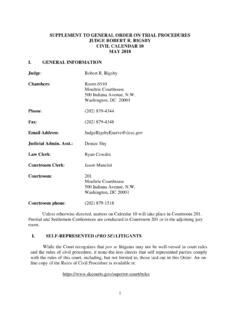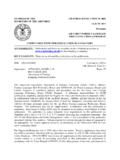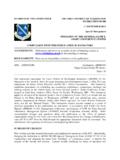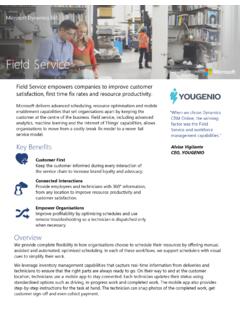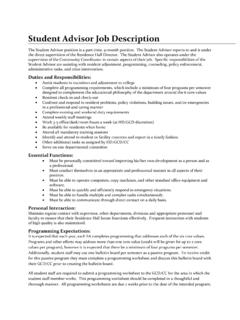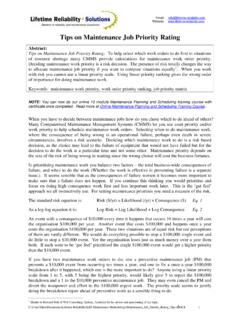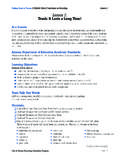Transcription of INTRODUCTION TO MANUFACTURING …
1 INTRODUCTION TO MANUFACTURING execution SYSTEMS MES CONFERENCE & EXPOSITION JUNE 4-6, 2001 Baltimore, Maryland Michael McClellan President MES Solutions Incorporated Terrebonne, Oregon 97760 541 548 6690 INTRODUCTION TO MANUFACTURING execution SYSTEMS By Michael McClellan 2 About the Author Mr. Michael McClellan is president of MES Solutions Incorporated, a company specializing in consulting services aiding clients in the design and implementation of MANUFACTURING execution Systems. Prior to his current position Mr. McClellan was President of a major supplier of material management and control systems. Before that he was a founder and President of Integrated Production Systems, a company that pioneered the development and implementation of computer systems for production execution . While at Integrated Production Systems he published two papers and numerous articles on the subject of applying computer systems in MANUFACTURING operations and managed the company that developed and installed systems for major clients.
2 Prior to forming Integrated Production Systems Mr. McClellan held officer level management positions in companies providing equipment and control systems for production and material management. In addition to his work experience Mr. McClellan is a member of the MANUFACTURING execution Systems Association (MESA International), American Production and Inventory Control Society (CPIM) and the Society of MANUFACTURING Engineers. He is a frequent speaker on MES, holds one patent, and is the author of the recently published book, Applying MANUFACTURING execution Systems. Mr. McClellan is interested in any comments and ideas regarding MES and can be reached by telephone at 541 548 6690 or Fax at 541 548 6674 or by mail at Box 2148, Terrebonne, Oregon 97760. INTRODUCTION TO MANUFACTURING execution SYSTEMS By Michael McClellan 3 Bridging the Gap Applying information technology to assist in the execution of production, through on-line management of the activities at the plant floor, has been a rapidly growing trend for a number of years.
3 Planning systems have been applied under a variety of titles, including Material Requirements Planning (MRP), MANUFACTURING Resources Planning (MRPII), Enterprise Requirements Planning (ERP), and MANUFACTURING Control Systems (MCS). Also in place for many years are modern control systems that manage or control a machine s functions such as PLCs used to run machine tools. The MES system bridges the gap between the planning system and the controlling system using on-line information to manage the current application of MANUFACTURING resources: people, equipment and inventory. With direct electronic connections to the planning system and the equipment control systems, the MES is the hub that collects and provides information and direction within the production activities. To support on-line management decisions the MES usually includes direct connection to functions such as SPC, Time & Attendance, Product Data Management, Maintenance Management, and any other similar tool.
4 A General Overview Technology Evolves The idea of using computers to manage MANUFACTURING activities is not new. The concepts that allowed the development of Materials Requirements Planning evolved from computer usage primarily within the accounting departments (the main users of early computers) and were extensions of tools used for cost accounting and inventory measurement. Even the systems used by MANUFACTURING have been oriented toward accounting and finance. This appears to be part of the reason for the distance between many MANUFACTURING professionals and true computer implementation on the MANUFACTURING floor. Many legitimate complaints are often stated about the computer systems used in MANUFACTURING . For example: The information is too old.
5 I don t have time to read such a big report. How much of this information applies to me. This information applies to accounting or MIS, not to MANUFACTURING . All this is history. I need to make decisions based on what is happening now. A new idea is evolving. In recent years a concept with many versions has been developed for MANUFACTURING managers a real tool that helps manage the MANUFACTURING floor, functions, resources, and inventory and gives accounting and MIS all the information they require. The best part is this idea is being built around the MANUFACTURING world and requires no advanced knowledge of computers. In most cases these systems run on smaller local computers and are fairly simple to use. MANUFACTURING execution Systems This concept has been around long enough to have a name: MANUFACTURING execution Systems (MES). As the name implies, MES is more than a planning tool like ERP or MRPII. MES is an on-line extension of the planning system with an emphasis on execution or carrying out the plan.
6 execution means: Making products. Turning machines on and off. Making and measuring parts. Moving inventory to and from WorkStations. INTRODUCTION TO MANUFACTURING execution SYSTEMS By Michael McClellan 4 Changing order priorities. Setting and reading measuring controls. Assigning and reassigning personnel. Changing order priorities. Assigning and reassigning inventory. Scheduling and rescheduling equipment. MANUFACTURING execution Tool The MES is a MANUFACTURING tool designed and built for MANUFACTURING . Most MANUFACTURING companies use a planning process (MRPII/ERP or equivalent) to determine what products are to be manufactured. Once that plan has been developed, there must be a translation of the plan that deals with real resources that are currently available. What is necessary is a method to take input from the planning system and translate that plan into a language that fits the plant floor and the resources required to execute the plan a major role for the MES.
7 What MES Can Do For You MESA International has conducted studies of companies using MES and offers the following benefits as reported by system users: Reduces MANUFACTURING cycle time. Reduces or eliminates data entry time. Reduces work-in-process inventory. Reduces lead times. Reduces paperwork between shifts. Improves product quality. Eliminates lost paperwork/blueprints. Empowers plant operations people. Improves customer service. Responds to unanticipated events. The potential gain by implementing MES addresses the need for immediate, current, on-line information that allows users or the MES computer system to make the best informed decisions regarding the application of inventory, plant resources, and people. Some examples include: 1. Engineering wants to locate all current work orders for a given product to determine the effect of an immediate engineering change order .
8 2. Some purchased material that is specific to a given customer s order currently in process has arrived as a partial shipment, 72% complete. Where is the order and what is the appropriate response? 3. A customer requires specific operator information including operator, date, and ambient conditions to be supplied with each item produced. 4. A process critical to production needs preventative maintenance. How are the current orders to be scheduled? 5. The president of a high-volume customer has just called and needs to know by tomorrow if he can double the quantity on the current order in house without affecting the delivery schedule. 6. There are 26 work orders totaling 443 hours of work for a specific routing location. What is the optimum sequence for these work orders and what factors should be considered? 7. A new quality assurance system has been installed that can receive and analyze data from the plant floor and provide current on-line results to the workstation operator.
9 8. Operator time is charged to each order and collected as the order passes through production through the use of a time card data collection system using bar code readers and menus. 9. Inventory can be retrieved from storage and sent to a specific workstation matching the production schedule. 10. The shift supervisor is considering replacing a part on a production machine and needs to know if the part is in stock and how long the maintenance work will take. 11. Information regarding inbound inventory can be gained by a through a communication link with the vendor s MES computer. 12. A sales representative is at a customer s office and needs to know where their order is in the production process. INTRODUCTION TO MANUFACTURING execution SYSTEMS By Michael McClellan 5 _____CORE FUNCTIONS The following is an overview of the core functions of the MES: Planning System Interface The MES should be directly coupled to the planning system to accept work orders and all other input and to provide upload information as necessary.
10 The communications should be two way so the MES can keep the planning system properly informed about plant activities such as labor data, inventory changes, and work order progress. Other methods of data entry and reporting can easily be accommodated, and in some cases, such as more continuous process, production orders may not be used at all. Work Orders The MES accepts the Work order through automatic or manual entry. It manages changes on orders, establishes and changes schedules, and maintains a prioritized sequenced plan. Releasing orders to production and establishing a current order priority list based on your sequencing rules is a normal part of MES. Frequently changes must be made to released orders. Within MES, order modifications such as these examples can be done easily: Enter schedule changes. Mark for material shortage. Enter quantity changes. Place on hold.

